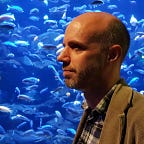‘He Walked by Night’ or — Tunnel Vision?
Alfred L. Werker and Anthony Mann’s (uncredited) ‘He Walked by Night’ (1948) starts with location footage of L.A. (“a bunch of suburbs in search of a city”) whilst a voice over describes this new type of city, the large police force needed to patrol it and the technology (radio hubs, information gathering systems, facial reconstruction techniques) now at their disposal. This is the face of modern America. This is the face of modern policing.
And the police will need all the technological help they can get because one of their officers, Officer Rawlins, has just been gunned down at point blank range by an unidentified assailant. Not only that but it seems this killer is a bit of a tech-head himself; an electronics expert who can listen in to police radio reports so can always remain one step ahead of the law.
After another cop is killed and another paralysed all possible witnesses are pulled in off the street and a composite photo of the killer is created from their various descriptions. Yet even though the cops now have a face they are still no closer to figuring out just who this guy actually is. It’s almost as though he must be someone with inside knowledge of how the police and their technologically advanced radio systems operate.
Several things are striking about ‘He Walked by Night’, the most immediate being just how incredibly modern this movie feels. It’s not just the documentary style or the emphasis on electrical and information systems but the fact the entire movie is vibrating with the pulse of the contemporary. The War is now over and this is a film that knows the World has radically, and permanently, changed.
Take the killer (named Roy). He makes his money selling stolen TV projectors, something I had NO idea existed in the 1940’s. Likewise with the police who seem to have the latest devices and procedures. It’s all very Fritz Lang except even more so.
Which brings us to another striking aspect of ‘He Walked by Night’, namely the lighting and cinematography, both of which are stunning! The screen is often cut by precise slices of light against compacted darkness, geometric shapes and forms demand our attention whilst extremes of contrast between background and foreground provides a sense of depth you could almost fall into.
This is best demonstrated by the climax — a thrilling and visually stimulating chase through the L.A. drainage tunnel system. This sequence contains some of the best torch action I’ve ever seen, the frantic beams of the killer’s beam skittering across the tunnel walls as he flees the relentlessly encroaching points of light of the inevitably enclosing dragnet. It’s a remarkable sequence of light, dark, tension, location, geometric shapes and gunfire.
The sound design is excellent, too, fully exploiting the almost endless reverb of these concrete tunnels, the BOOMS of shotgun blasts echoing with sustained power like a clanging toll signaling death. This combination of intense blackness, blinding light and deafening BLAMS makes for an exciting and artistically impressive climax.
‘He Walked by Night’ is a furiously paced, smartly written and energetically directed thriller. It bristles with tension and when violence occurs it’s explicit and shocking (there’s a scene where Roy, to avoid going to hospital, performs surgery on himself to remove a bullet from his side and it’s pretty icky to watch). This is a film noir but boy, they could’ve made this film in the Sixties, or even the Seventies, and it wouldn’t have dated in the slightest.
